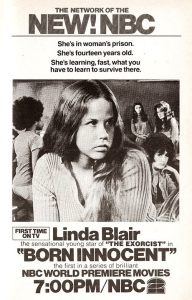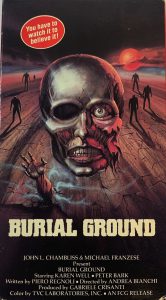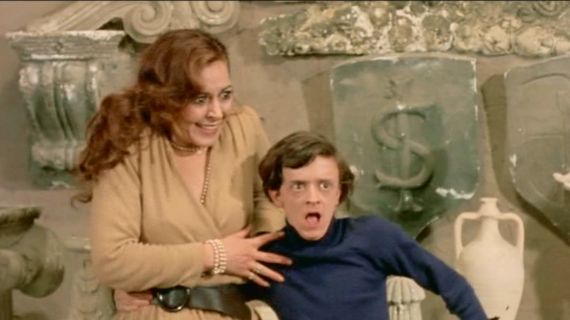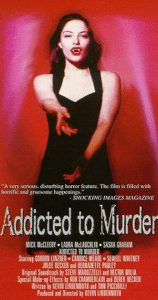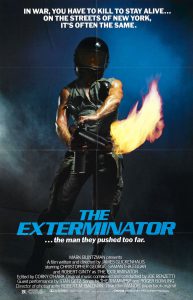The Initiation of Sarah (1978) by #RobertDay#KayLenz #ShelleyWinters #MorganFairchild
An innocent coed, a secret sorority, its bizarre rights of womanhood… a quiet college campus is plunged into an endless night of terror!#NotQuiteClassicCinema pic.twitter.com/a6tBqhsKqB
— Angus Kohm (@AngusKohm) May 22, 2021
There are a lot of movies called The blank of blank (insert action in first blank and name of person in second blank). The Seduction of Joe Tynan (1979), The Violation of Sarah McDavid (1981), The Seeding of Sarah Burns (1979) and the less formal The Seduction of Gina (1984), The Awakening of Candra (1983), The Initiation of Sarah (1978), The Violation of Claudia (1977), The Taming of Rebecca (1982), The Taking of Christina (1976) – the list goes on and on. It seems as if the second blank – the name – most often represents a woman, while the movies themselves most often fall into one of two categories: Made For TV Movies of the Week or Golden Age Adult Cinema. Can you tell by the titles which ones are which? Probably not. But both categories are fertile ground for Not Quite Classic Cinema.
The Initiation of Sarah (1978) falls into the first category and was in fact an ABC Monday Night Movie. I didn’t see it back then, in sprite of the fact that I was always on the lookout for scary movies on TV. I remember watching other made for TV horror films that year, like Summer of Fear (1978) – which I believe was called Stranger In Our House at the time – but The Initiation of Sarah somehow came and went without me even noticing it.
I sometimes talk about the fact that home video, or VCRs, really took the place of going to the drive-in for people of my generation. We were too young to drive cars or get into R-rated movies, but we were somehow allowed to rent those same weird and forbidden movies on VHS and Beta. Our VCRs became the home drive-ins of our youth, and we took full advantage.
Prior to those glorious days, made for TV horror films – and other edgy genres that were somehow adapted for TV – were all that we underage trash junkies could access. Anyone remember made for TV women in prison films like Born Innocent (1974) with Linda Blair and Cage Without a Key (1975) with Susan Dey? If VCRs were the home drive-in of my youth, then made for TV movies were the home drive-in of my childhood.
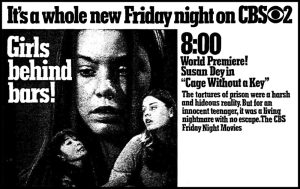 I suppose it’s no surprise that once we were able to rent R-rated theatrical movies, we lost interest in the made for TV stuff. Some of those old TV movies were released on VHS and Beta. It wasn’t always easy to tell if a movie had been made for TV, but we would look for words like “teleplay” in the credits. Whenever we found one on the shelf, we would laugh and scoff at the idea of renting it. Our attitude seemed to be “This movie won’t be any good… it won’t be scary… it won’t have any gore or nudity in it… it’s made for TV so it will be suitable for children – yuck!” So if I came across a copy of The Initiation of Sarah in those days, I would have avoided it like the plague.
I suppose it’s no surprise that once we were able to rent R-rated theatrical movies, we lost interest in the made for TV stuff. Some of those old TV movies were released on VHS and Beta. It wasn’t always easy to tell if a movie had been made for TV, but we would look for words like “teleplay” in the credits. Whenever we found one on the shelf, we would laugh and scoff at the idea of renting it. Our attitude seemed to be “This movie won’t be any good… it won’t be scary… it won’t have any gore or nudity in it… it’s made for TV so it will be suitable for children – yuck!” So if I came across a copy of The Initiation of Sarah in those days, I would have avoided it like the plague.
Fast forward a bunch of years, and I started to realize that a lot of those old TV movies were actually good. As I’ve talked about in previous posts, my friend Brian and I have actually taken to seeking out old TV horror films and watching them during our annual all day movie marathon. And I think I speak for both of us when I say that a lot of the R-rated movies we watch can’t hold a candle to classic made for TV movies like The Night Stalker (1972) and Don’t Be Afraid of the Dark (1973). A few years ago I purchased a Shout Factory TV Terrors DVD that included The Initiation of Sarah. I brought it with me to our annual movie event a few years in a row, but for some reason we kept passing it over in favour of other films. Last year, thanks to the current pandemic, we were unable to hold our event – and it seems doubtful that we will be able to reschedule it any time soon. So, last week I decided that perhaps it was time for me to investigate this particular TV terror on my own (sorry, Brian)…
The Initiation of Sarah is not quite in the same class as made for TV masterpieces like The Night Stalker, but it’s a pretty darn entertaining film. I think it’s fair to say that it’s one of many post Carrie (1976) films that were majorly influenced by it. The term rip off, or knock off, might be used to describe it (and not entirely unfairly). It does manage to distinguish itself with some other, non Carrie-like elements. For one thing, Shelley Winters guest stars as Mrs. Erica Hunter – not Sarah’s overbearing, insanely religious mother, which would have been too on the nose in terms of recreating Piper Laurie’s role in Carrie (but I somehow found myself making that connection anyway) – no, Shelley Winters plays the quirky den mother to the uncool sorority that Sarah manages to join (the only one that will have her). If the movie had stopped there, things would have been okay, if a little ordinary. But it turns out that Mrs. Erica Hunter is some sort of expert on witchcraft and the supernatural – and she recognizes that Sarah has some extraordinary powers. At the risk of including a mild SPOILER, by the final reel of the film, Shelley’s performance takes a sharp turn from quirky, interfering den mother to full on Satanic Priestess, and – as anyone who knows Shelley Winters can likely imagine – she does it very well.
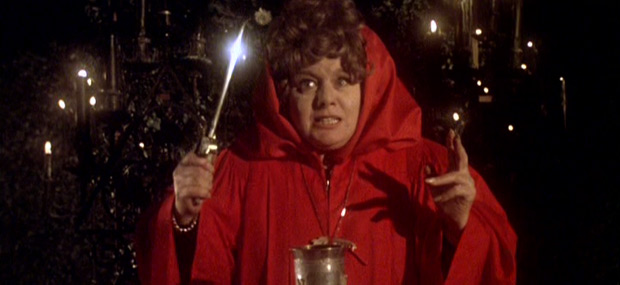 The rest of the cast is pretty stellar as well. Kay Lenz stars as Sarah Goodwin (doesn’t that name somehow ooze witchcraft? Maybe it’s just me). You might recognize her from movies like House (1985), Stripped to Kill (1987) and the early Clint Eastwood directorial effort Breezy (1973). I first got to know her in one of my all time favourites, Death Wish 4: The Crackdown (1987). She also stars in one of the other TV movies I mentioned earlier, The Seeding of Sarah Burns (1979).
The rest of the cast is pretty stellar as well. Kay Lenz stars as Sarah Goodwin (doesn’t that name somehow ooze witchcraft? Maybe it’s just me). You might recognize her from movies like House (1985), Stripped to Kill (1987) and the early Clint Eastwood directorial effort Breezy (1973). I first got to know her in one of my all time favourites, Death Wish 4: The Crackdown (1987). She also stars in one of the other TV movies I mentioned earlier, The Seeding of Sarah Burns (1979).
There is also a very bad blonde sorority girl who tries to make Sarah’s life hell (somewhat reminiscent of Nancy Allen in Carrie) played by Morgan Fairchild. I recall seeing her play a string of “bad blondes” back in the 1980s. The Initiation of Sarah was a relatively early effort from her, but she already had the woman-you-love-to-hate thing down. It’s no surprise she went on to star in some prime time soaps, like Flamingo Road (1980-82).
The movie was directed by Robert Day, who has almost 100 credits as a director, mostly in television. He did make a few theatrical feature films early on, including The Haunted Strangler (1958) with Boris Karloff and Corridors of Blood (1958) with Boris Karloff and Christopher Lee.
The Initiation of Sarah (1978) is a perfect example of #NotQuiteClassicCinema made for TV in the 1970s. Even though I had never seen it before, it gave me powerful feelings of nostalgia. The actors, the music, the atmosphere, the suspiciously familiar story – it all adds up to cinematic Déjà Vu of the very best kind. If you didn’t grow up watching these kinds of movies at your home drive-in, you might not appreciate it quite as much as I do, but it should still provide enough entertainment value to justify 96 minutes of your time. It will certainly always be a welcome sight for me on a #FridayNightAtTheHomeDriveIn.

